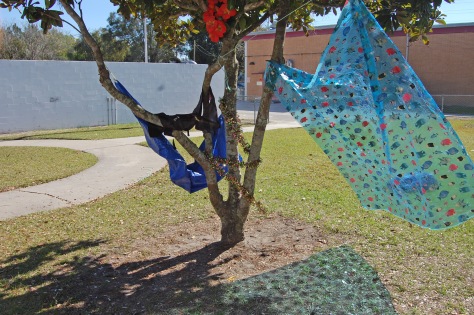 Examination of Maya Lin’s A History of Water exhibit Water Line installation
Examination of Maya Lin’s A History of Water exhibit Water Line installation
Over the past few years OMA has done exceptionally well on two shows I can remember: Chihuly Across Florida (2004, along with several Florida museums) and the delightful Grandma Moses in the 21st Century (2001) show. Last year my students were able to see the Speed collection, Rembrandt, Rubens, Gainsborough and the Golden Age of Painting masterworks of Flemish, Dutch and French art. The year before a glass show, which actually interested them more than paintings could, and which we came away with more ideas on design and light installation.
 Jude Mojher (center) explains the apex of Water Line.
Jude Mojher (center) explains the apex of Water Line.
 Student work compared with Maya Lin’s Water Line.
Student work compared with Maya Lin’s Water Line.
In August, working with teachers, we tried to pull the museum trip together for 5th graders. I was not too sure about Maya Lin, as I knew her work from the Vietnam Memorial, and other work with a sculpture museum in New York, but I was not aware of her recent work or how students would react. In my school, students are very open. That was one thing in our favor, I remember telling them about Franz Kline and also Christo and how some people thought that their work was crazy, my students voiced they couldn’t understand why.
Allowing the kids to experience creating an installation is one thing, but actually using it as a springboard for the Maya Lin exhibit is something else. I have done installation before, but this time I have less “stuff,” so the look is more austere than it was when I started this way back when 5 years ago. In those days I was fresh to it, now some of the fun is gone, passed over to my students to enjoy.
Says one boy, “This is the best day ever in art.” Hm? More interpretive work, Franz Kline, Rothko or Christo does not fluster them. They were enthralled by Richard’s Serra’s work that I powerpointed from so-so shots of his MoMA show several years ago, which was so much fun. Two students were in New York, although they have had to have been quite young to see the Christo show in Central Park.
I spend a lot of time while and after they have done an installation, looking at how they used the space and how rather than superimposing themselves on the space, they linked it together. From meager use of clothesline, rope, fabric, tarps, students were told not
to go two dimensional in their space, but create a sculpture. Students chose often trees wrapping, tying even breaking off small branches and reusing tree branches to create an artwork. They sections off spaces, sometimes clotheslining tarps, amid the wind.
 Part of the History of Water exhibition, this took up an entire gallery and needed to be walked around several times.
Part of the History of Water exhibition, this took up an entire gallery and needed to be walked around several times.
 Students’ interior installation.
Students’ interior installation.
So I used the installation as an assignment, to put them in the spirit of a more open way of perceiving an artist vision. An artist such as Maya Lin, whose current vision with A History of Water exhibit challenges the traditional view of art, but in a strange way goes beyond to embrace it. While so much of art explores the surface, Lin’s knowledge take Super Realism to a new level. It is not enough to be like Close or Estes in recreating the surface, one goes a little bit further to examining the essence.
A river is no longer a representation of a river in local terms, but goes on to cartographic heaven by actually plotting it. The topography of meridians, now becomes stuff to create sculpture in the round. Her vision is a super-reality, sort of like Scarlett Johansson’s Lucy meets Leonardo. This is heady stuff.
One student came back to tell me he liked last year’s show better as he liked paintings. His teacher on the other hand, loved the show and loved the docent. Another student screamed at me why she has to go. She was calmly overtaken by two students who looked at the show quite differently, and only wished there was more. They had both seen the video (above), when the screaming student had been pulled out, along with others, to discuss a referral. We will be discussing it for a while down the road, as my students and I, explore Art and making art. I thank both Jude Mojher and Christina Owen for helping my students and me.
To compound, or alleviate my dilemma, last night I went to a lecture at Rollins College, Making to Think with artist/professor Aithan Shapira. His approach to andragogy utilizes the making of art as a way towards creativity and therefore the strengthening of cognitive processes. While his personal approach to art deals more with actual surface, his lecture channels the creative process as a means of enabling neurological synaptic connections.
He is one of the few people, I have ever heard refer to skill sets. This is an important, and increasingly, neglected part of the process. I thought of holding the paper as I get some of my kindergartners to cut. It was interesting listening to this young man speak, who could have been a dead ringer in mannerism to Chuck Dzuiban, my own mentor, thirty years ago. My thanks to Barbara Hartley.












